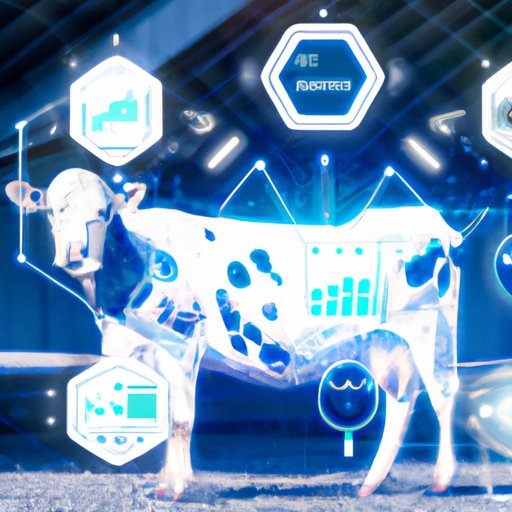Introduction
Artificial intelligence (AI) is a rapidly evolving technology that has the potential to revolutionize many aspects of daily life, from our homes and workplaces to the way we manage livestock. AI-driven systems can provide farmers with powerful insights into their herds, helping them monitor and manage cows more efficiently and effectively. In this article, we explore how AI can be used to manage cows, from automating herding and health monitoring to improving production efficiency and the quality of milk products.

Utilizing AI to Automate Cow Herding and Management
Herding cows can be a labor-intensive process, particularly when herders need to manually identify and track individual animals. However, AI-driven systems can help simplify this process by leveraging computer vision algorithms to automatically detect and track cows. For example, researchers at the University of Cambridge have developed an AI-powered system that uses a camera mounted on a drone to accurately identify and track cows in a herd. This system can also be used to measure the size of each cow and detect any abnormalities, such as lameness or injuries.
In addition to drones, other technologies such as sensors and GPS tracking can be used to better monitor and direct a herd’s movements. For instance, researchers at the University of Missouri have developed an AI-driven system that can detect changes in a herd’s behavior, such as when cows start to move away from the herd, and then alert the herder to take action. This system can also be used to create virtual fences that can keep cows within a designated area.
How AI-Powered Sensors Can Monitor Cows’ Health
Sensors and cameras can also be used to measure vital signs, such as body temperature, heart rate, and respiration rate, which can provide valuable insights into a cow’s health. For example, researchers at the University of California, Davis have developed an AI-driven system that uses infrared cameras to measure a cow’s body temperature and detect signs of illness. This system can also be used to monitor a cow’s eating habits and activity levels, providing farmers with valuable data that can help them optimize production processes.
AI-powered health monitoring and diagnostics can also be used to detect diseases and other medical issues before they become serious. For instance, researchers at the University of Wisconsin have developed an AI-driven system that can detect signs of mastitis, a common disease in dairy cows, by analyzing images of the udder. This system can alert farmers to any potential issues so that they can take appropriate action.

Exploring the Potential Benefits of Artificial Intelligence in Dairy Farming
AI-driven systems can also be used to enhance data collection and analysis, helping farmers optimize production processes and improve efficiency. For example, researchers at the University of Illinois have developed an AI-driven system that can analyze data from sensors and cameras to identify areas where production could be improved. This system can be used to track feed intake, cow movement patterns, and other factors that can impact production efficiency.
In addition, AI-driven insights can be used to improve feed quality and animal welfare. For instance, researchers at the University of Arizona have developed an AI-driven system that can analyze data from sensors to monitor a cow’s diet and ensure that it is receiving the proper nutrients. This system can also be used to detect any issues with a cow’s overall health, such as dehydration or heat stress.
Harnessing AI for Greater Efficiency in Livestock Production
AI-driven automation can also be used to reduce labor costs and optimize processes. For example, researchers at the University of Florida have developed an AI-driven system that can automate the milking process, reducing the amount of time needed to milk a cow and freeing up workers for other tasks. This system can also be used to detect any anomalies in the milk, such as bacteria or contaminants, and alert the farmer to take corrective action.
AI-driven decision making can also be used to support sustainable production practices. For instance, researchers at the University of Nebraska have developed an AI-driven system that can analyze data from sensors and cameras to identify areas where production could be improved without negatively impacting the environment. This system can also be used to detect any potential issues with water or air quality, alerting farmers to take action to ensure that their operations remain compliant with environmental regulations.

Exploring the Potential Benefits of Machine Learning in Milk Products
Machine learning can also be used to assess milk safety and quality. For example, researchers at the University of California, Berkeley have developed an AI-driven system that can analyze data from sensors and cameras to detect any contaminants or impurities in milk. This system can also be used to detect any changes in milk quality over time, allowing farmers to adjust their production processes accordingly.
AI-driven predictive analytics can also be used to anticipate market demands. For instance, researchers at the University of Washington have developed an AI-driven system that can analyze historical data to predict future trends in milk consumption. This system can alert farmers to any changes in demand so that they can adjust their production accordingly.
Conclusion
In conclusion, AI-driven systems can provide farmers with powerful insights into their herds, helping them monitor and manage cows more efficiently and effectively. These systems can be used to automate herding and health monitoring, enhance data collection and analysis, improve production efficiency, and even assess milk safety and quality. By harnessing the power of AI, farmers can gain greater control over their operations and ensure that their cows receive the best possible care.
(Note: Is this article not meeting your expectations? Do you have knowledge or insights to share? Unlock new opportunities and expand your reach by joining our authors team. Click Registration to join us and share your expertise with our readers.)
